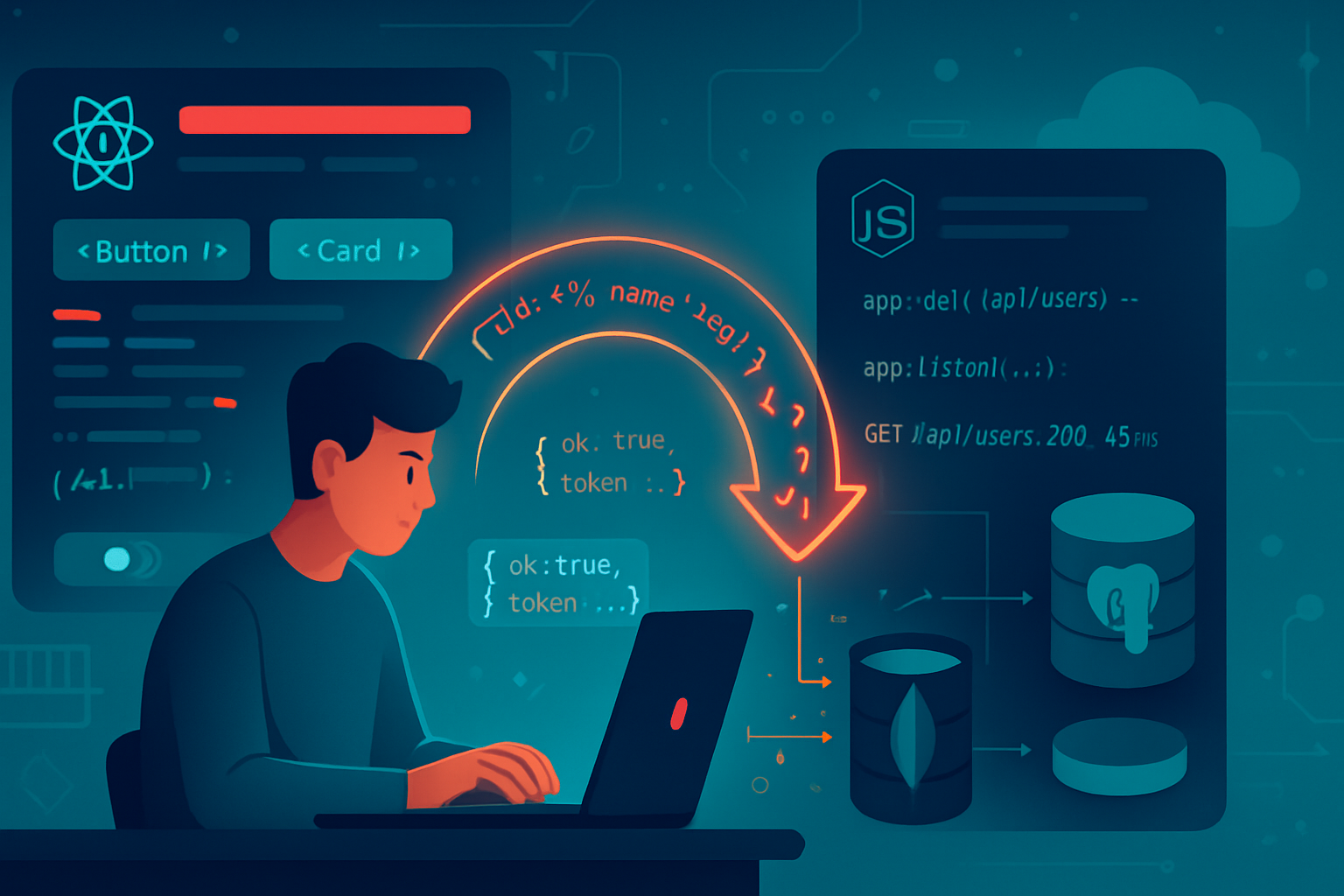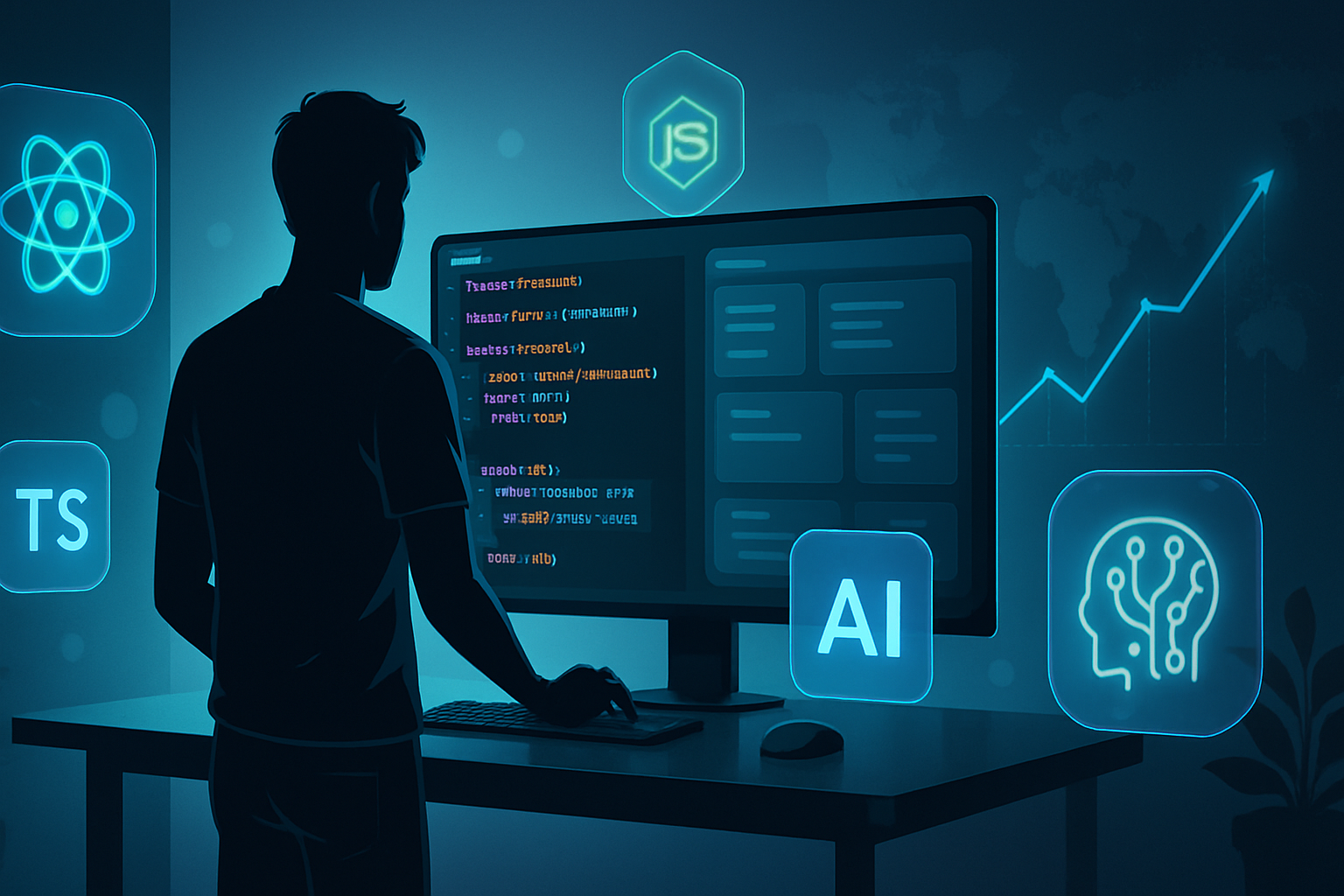· career · 6 min read
From React to Node: Bridging the Gap between Frontend and Full-Stack Development
A practical guide for React developers who want to become full-stack engineers. Learn the mindset shifts, core technologies, a step-by-step learning roadmap, real projects to build, and vetted resources and courses to accelerate the transition.

Outcome-first introduction
By the end of this article you’ll have a clear, practical roadmap to go from building React UIs to shipping full-stack apps. You’ll know the key technologies to learn, the mindset changes that matter most, a week-by-week learning plan, project ideas with increasing complexity, and the best resources and courses to get you there fast. Ship end-to-end features. Own the full experience.
Why many React developers choose full-stack
Front-end work teaches you to think in components, UX and performance. That’s valuable. But when you build the API by yourself, you stop guessing how data flows. You fix real bottlenecks. You debug faster. You deliver features holistically.
Transitioning is not about becoming an expert in everything. It’s about acquiring complementary skills that let you design, implement, and deploy full features - from UI to persistent data and production infrastructure.
The mental shifts you need (quick and critical)
- From ephemeral UI state to persistent system state. UIs rerender. Data in the backend persists and needs integrity.
- From synchronous UI logic to asynchronous, long-running, and I/O-bound server logic. Expect latency and partial failures.
- From local-only thinking to multi-actor systems (concurrency, race conditions, caching, and scaling).
- From single-page performance issues (bundle size, hydration) to full-stack performance (DB indexes, query shapes, caching layers).
Make these mindset changes early. They shorten the feedback loop and reduce frustration later.
Core tech and concepts to learn (the essential checklist)
- Node.js basics: event loop, async/await, streams, process lifecycle. (Node.js docs)
- HTTP fundamentals: status codes, headers, methods, CORS, caching.
- Express (or Koa/Fastify): routing, middleware, error handling. (Express docs)
- APIs: REST design, versioning, error contracts. Then level up to GraphQL if needed. (GraphQL)
- Databases: relational (Postgres) and NoSQL (MongoDB). Learn query patterns and when to pick one. (MongoDB University)
- ORMs/Query Builders: Prisma, Sequelize, TypeORM, or raw SQL with node-postgres. (Prisma)
- Authentication & Authorization: sessions, JWTs, OAuth flows, refresh tokens.
- Real-time: WebSockets or libraries like Socket.io for notifications and collaboration. (Socket.io)
- TypeScript on the server: types catch bugs early and make APIs self-documenting.
- Testing: unit tests, integration tests, and API contract tests (Jest, Supertest).
- DevOps basics: Docker, environment variables, secrets, CI/CD, and simple deployments (Vercel, Heroku). (Docker)
- Observability: logging, metrics, and error reporting.
- Security basics: input validation, rate limiting, encryption-at-rest/in-transit.
These will cover 80% of the day-to-day tasks you’ll face.
Tools and workflow every full-stack React dev should use
- Editor: VS Code (with ESLint, Prettier, and TypeScript plugins).
- HTTP clients: Postman or Insomnia for testing endpoints. (Postman)
- Database GUI: TablePlus, DBeaver, or MongoDB Compass.
- Package managers: npm, Yarn, or pnpm.
- Containerization: Docker for creating reproducible dev environments.
- Git and branching strategies. (Git docs)
- Feature-driven local infra: use Docker Compose for running DB + Redis locally.
- CI/CD: GitHub Actions or GitLab CI for automated tests and deployments.
Use automation where you can. It pays back immediately.
A practical step-by-step learning roadmap (12 weeks - flexible)
Week 1–2: Node fundamentals
- Read Node docs and build small CLI scripts.
- Learn async/await, Promises, and error handling.
Week 3–4: HTTP and Express
- Build a basic Express API with CRUD routes.
- Add middleware for logging, validation, and error handling.
Week 5–6: Data layer
- Integrate a database (MongoDB or Postgres).
- Use an ORM/Query builder. Write migrations.
- Add basic indexes and learn query profiling.
Week 7: Authentication & Security
- Implement JWT-based auth or sessions.
- Protect routes and learn common security pitfalls.
Week 8: TypeScript + Testing
- Migrate the API to TypeScript incrementally.
- Add unit and integration tests (Jest + Supertest).
Week 9: Real-time and advanced APIs
- Add a WebSocket/Socket.io feature.
- Explore GraphQL if your data needs it.
Week 10: Containerize and deploy
- Dockerize the app. Deploy to a simple platform (e.g., Heroku, Vercel, or a small VPS).
- Add basic CI pipelines.
Week 11–12: Polish and scale
- Add caching (Redis) for hot data.
- Add observability (logs, metrics) and a basic load test.
Adjust pacing to your schedule. Build projects as you learn - you’ll retain far more.
Project roadmap - build to learn (with increasing complexity)
Starter (1–2 days): Simple Notes API
- CRUD endpoints, persisted to a DB.
- Connect from a small React UI.
Intermediate (1–2 weeks): Authenticated Task Manager
- Sign-up/login, private tasks per user, file uploads.
- Pagination, search, and filter endpoints.
Advanced (3–4 weeks): Real-time Collaborative Board
- Real-time updates with WebSockets (collaborative editing or flight of tasks).
- Use optimistic UI in React and reconcile conflicts.
- Add background jobs (e.g., emails) and queue processing (Bull/Redis).
Production-ready (ongoing): e-commerce micro-service stack
- Payments integration, inventory, orders, and microservices.
- Service-to-service auth, event-driven design (Kafka or Redis streams), and automated deploys.
Each project should be deployed publicly. Real world problems teach more than tutorials.
Small, practical example (Express + MongoDB skeleton)
// app.js (minimal)
const express = require('express');
const mongoose = require('mongoose');
const app = express();
app.use(express.json());
const NoteSchema = new mongoose.Schema({ text: String, createdAt: Date });
const Note = mongoose.model('Note', NoteSchema);
app.get('/notes', async (req, res, next) => {
try {
const notes = await Note.find().sort({ createdAt: -1 });
res.json(notes);
} catch (err) {
next(err);
}
});
app.post('/notes', async (req, res, next) => {
try {
const note = await Note.create({
text: req.body.text,
createdAt: new Date(),
});
res.status(201).json(note);
} catch (err) {
next(err);
}
});
app.use((err, req, res, next) => {
console.error(err);
res.status(500).json({ error: 'Internal server error' });
});
mongoose
.connect(process.env.MONGO_URL || 'mongodb://localhost:27017/app')
.then(() => app.listen(3000, () => console.log('Server listening on :3000')))
.catch(console.error);This is intentionally minimal. Add validation, error handling, auth, and tests before going to production.
Courses, docs, and curated resources
- Node & Express: Node.js official docs - https://nodejs.org/en/docs/
- REST & HTTP basics: MDN Web Docs - https://developer.mozilla.org/
- free interactive curriculum: freeCodeCamp
- Full-stack JavaScript path: The Odin Project
- Practical Node courses: Frontend Masters - Node.js courses
- Deep, project-based Node course: Udemy - The Complete Node.js Developer Course
- Databases and ORMs: Prisma, Mongoose
- GraphQL: https://graphql.org/
- Docker: https://www.docker.com/
- Postman (API testing): https://www.postman.com/
Pick a couple of these and stick with them. Depth beats breadth.
Real anecdotes (what actually helped people)
A React developer I worked with started by writing an API for a small side project. She made mistakes (leaky error messages, insecure token handling), fixed them, and in two months was shipping full-stack features - faster and more confidently than before.
Another teammate learned Node by porting a server-rendered feature to an API + React frontend. The project forced him to learn migrations and DB indexing; those lessons made his front-end optimizations more purposeful because he stopped overfetching data.
These aren’t magic stories. They follow one pattern: small, real projects + incremental improvements.
Pitfalls to avoid
- Don’t try to learn everything at once. Focus on the 20% that delivers 80% of value: Node basics, one DB, authentication, and deployment.
- Don’t skip testing and CI. Shipping without them is stressful and slows you later.
- Beware of premature optimization. Profile before optimizing database or caching.
Final checklist before you call yourself full-stack
- You can design and implement a REST API and connect it to a React app.
- You can persist data reliably and reason about data models.
- You can handle authentication and protect sensitive routes.
- You can deploy an application and set up a basic CI pipeline.
- You have at least one deployed project that scratches a real itch.
Becoming full-stack is not a certificate. It’s about capability. It’s about shipping features end-to-end and owning the user experience from first click to last byte. That ability is what changes how you design UIs and systems. Own the full story. That’s the real edge.



